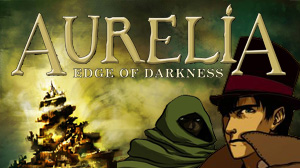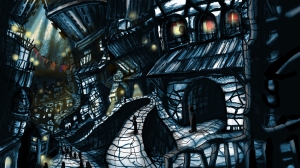Welcome back to the conclusion of our chat with Lisa England about the world of Aurelia: Edge of Darkness
Read Part One here
Read Part Two here
Airship Ambassador: Aurelia has been out a few weeks now, what reactions and feedback are you getting?
Lisa England: The feedback has been very positive, both from actors and from observers interested in the progress of the show. People think the concept is original and engaging, and they love the aspect that anyone anywhere can get involved.
[blog link – Non-Euclidean Æthercast #20: The Aurelia Experience]
AA: What advice would you have for someone pondering the idea of creating their own co-operative story?
LE: Decide first if it’s going to be a LARP (game-driven system) with many rules and clear winners, or if it’s going to be a more free-form collaborative story. That decision will influence many others. After that, be sure you’re creating a world where actors have lots room to play and many possibilities to follow. Finally, be flexible! It probably won’t go like you expect at all. Take whatever challenge comes next, and you’ll be able to maximize the experience for everyone.
AA: With all the background you’ve talked about, the project itself sounds amazing, and a ton of work. How did you actually wind up “here”? Was this journey even partially planned?
LE: Ha! The notion of a “planned” artistic journey seems strange to me now, although for some reason I used to think it was possible. I suppose it happens that way for some, but the majority of artists and storytellers I know have followed a winding path. I’m no exception.
In 2009, I withdrew from a fully-funded PhD program to pursue my passion for storytelling. That led me to screenwriting (combining my strong visual thinking with my passion for words. Later I was blessed to attend the rigorous Act One program in Los Angeles, taught by some of today’s top writers and producers. I did get hired as a screenwriter on a decently-budgeted indie film, but realized quickly that trying to salvage an already-struggling production wasn’t what I had in mind for a career.
After that, I floundered for awhile, writing the story that eventually became Rise of the Tiger all the while, along with lots of other unfinished ones. I studied more with industry mentors, too. But finally, I got so fed up with being told “no” or “you’re not good enough yet” or “make it more marketable” that I lost my joy in creating. It wasn’t that I didn’t want to improve. My ideas were considered so bizarre or unique or “unusual” that people trying to “mainstream” them got frustrated. And so did I. Thankfully I got the courage to say, “Enough already!” in 2012. I decided that, from then on, I would be the one to decide when to publish, produce or otherwise share something publicly. And if that meant I was anonymous forever, doing what I loved for a niche audience, that was fine by me. It was the most liberating decision I ever made.
Two months later I began serializing Rise of the Tiger, and through that process I met the amazing artists who illustrated almost every episode—something I never imagined at the beginning. I got braver about sharing my work online through that process, too. Right about that time, Seth Godin also published his book Icarus Deception that basically argues for what I’m doing right now—taking ownership of my career, and not waiting to be “found” by an arbitrary creative gatekeeper. It gave me a lot of courage to continue this path.

A year ago, I could have never done a Theatrics show. If you had known me then, I was a different artist. But by doing Rise, I was ready when Theatrics called. It’s been a really hard step-by-step journey, and I am both excited (and a little freaked out) to see what challenge I might have to take up next! Nothing I’ve done is perfect; in fact, I’m not satisfied with any of it! But I AM satisfied that I learned and grew a ton. I hope to go away from every project saying that.
AA: You have a day job at a marketing agency and Aurelia is that “other job/passion/hobby”. How has the day job been to help/hinder the work with Aurelia?
LE: It’s been a big help and hindrance. A help, in that my bosses are hugely supportive and are very lenient time-wise with me while I explore this new medium, which they’re excited about. They see cross-over with our client work. But like any day job, there are responsibilities I must take care of. I’m not always able to respond to actors as fast as I’d like, and I certainly don’t post my character videos as fast! It’s a daily balancing act, and I try not to beat myself up if I don’t strike it quite right. Tomorrow is a new day!
AA: What do you do to keep a balance between job, Aurelia, and the rest of your life?
LE: Hmmmm. Balance? J Storytelling is my life, and I’d go nuts without it. My husband and I are both blessed (or cursed) with extreme focusing abilities; we each love what we do and are pretty happy to let the other obsess over their latest passion project. So I don’t think I have a life like most people. I have friends and hang out with them sometimes, but most of the time I’m working on work or Aurelia or a new creative project or my collaboration with City Beast Studio. Mastery demands that I say “no” to a lot of other things in life in order to get good at my craft. Fortunately, I love doing it—so I don’t mind having a lot less “free time” than most people would think sane. J
AA: If you weren’t a writer and working on Aurelia, what else would you be doing now?
LE: Backpacking through the Middle East, from Morocco to Dhubai, and filming some kind of web series along the way.
AA: How have you and your work grown and changed over time?
LE: Well, the first novel I ever wrote (which was my first big creative attempt of any kind) was a 400 page beast called Blade & Bow—which became the seed of the story Rise of the Tiger ultimately told. I guess the reference to weaponry gives the genre away. Total high fantasy! I hadn’t discovered steampunk at that time, and the story would go through a jillion iterations to arrive at the current form. So I’ve shifted from writing pretty stock high fantasy to (attempting!) to blend genres like fantasy and steampunk and exploring alternate forms.
Also in the early days I wrote screenplays, so I’ve always enjoyed more visual storytelling forms, and I think that has influenced my move to try new storytelling platforms and experiment with transmedia. My old motto was, “Make it perfect and get it published by a respectable publishing house!” My new motto is, “Maximize the potential of anonymity by experimenting wildly with new forms and self-publishing!” Not that I wouldn’t enjoy telling stories through more traditional means, but there is great joy and fascination to be had in these new realms, for storytellers willing to “go there.”
AA: Looking beyond Aurelia, what other interests and topics fill your time?
LE: Writing. Film. My blog about storytelling at http://journeycraft.tv. Learning languages and exploring random historical topics like water clocks, Renaissance fashion and mechanics. Basically, I try to learn and explore as much as possible in many different fields, because it fuels my creativity for writing and storytelling. I’m especially excited about “Steam School,” which I’m attending in September. Sponsored by the Wisconsin Historical Steam Society, this class is really for people who own antique steam vehicles (like tractors) and want to learn to drive and care for them properly to display them at fairs, conventions, etc. I said, “Hey, what a great event for a writer to learn more about how steam engines really work in order to write better about steam-powered societies!” So I’m going to steam school with lots of farmers and antique vehicle enthusiasts. Ha!
AA: What other fandoms are you part of in some way?
LE: Hmmm. Being a creator, I dabble and consume a lot of different types of stories, so I can’t say that I’m part of any one fandom. I really love Miyazaki’s anime films and the TV show Firefly … so (in addition to Steampunk) if I were to be a “fangirl” it would be for those!
AA: How do those interests influence your work?
LE: Well, Miyazaki inspires me to pull really random elements together. (Of course, from a Japanese perspective the elements of his films make great sense—but from an untrained Western perspective, sometimes the associations can seem “random,” and he definitely pulls from literary traditions all over the world.) Firefly does this too by pulling together space opera, the old west and Asian elements. I’m trying to do more of this in my work. The wilder the association, the greater the challenge for my brain to pull it all together into a cohesive singularity. This is why I tend to resist absolute adherence to genre conventions. I’m a mad story scientist. I want to innovate—and innovation usually means putting together things that nobody else would think to connect.
AA: Totally random questions as we wrap up – what is your favorite texture, time of day, and weather?
LE: My favorite texture is tooled leather; favorite time of day is early morning (if I’ve had enough sleep!); favorite weather is drizzly and gray—the kind of weather that makes me want to curl up with a good novel, a flickering candle and chocolate chip cookies!
AA: Any final thoughts to share with our readers?
LE: First off, I would love to have you join our crazy awesome cast in Aurelia! Lots of room to play, freedom to create, and there’s plenty of space for new actors. Second off, don’t wait until you’ve read or watched everything. Seriously, just visit the “Getting Started” page, look over what’s there, and then dive in. And finally, if you’re inspired to create something yourself and share it—whether it involves audience participation or not—DO IT. “I can’t” is a total lie (don’t tell yourself lies!) and “but I’m not good enough” is also a lie. Amazing things don’t happen until you take the first step. Every invention starts with an idea—and an inventor who acted on it. And as we all know, Steampunk celebrates inventors! 🙂
Thank you so much, Lisa, for spending time with us and sharing the world of Aurelia!
Keep up to date on the latest activities, and get involved, in the city of Aurelia: Edge of Darkness





